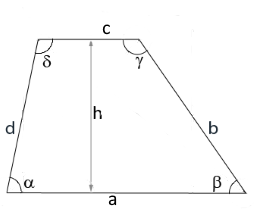Calculate Trapezoid Angles
Calculator and formulas for calculating trapezoid angles
Trapezoid Angle Calculator
Trapezoid Angle Calculation
The angles of a trapezoid are calculated from the height h and a side length (b or d). Choose which angles should be calculated.
Trapezoid with Angle Markings

The diagram shows a trapezoid with angles α, β, γ, δ as well as height h and sides b, d.
Angle calculation is performed using trigonometric functions.
Angle Relationships in Trapezoids
The angles of a trapezoid have special geometric relationships:
- Supplementary angles: α + δ = 180°, β + γ = 180°
- Angle sum: α + β + γ + δ = 360°
- Parallel sides: Create equal co-interior angles
- Trigonometry: Angles calculable via sin⁻¹(h/Side)
- Special case: In right trapezoids some angles are 90°
- Symmetry: In isosceles trapezoids: α = β, γ = δ
Formulas for Trapezoid Angle Calculation
Angle Alpha (α)
Calculation using height h and side d
Angle Beta (β)
Calculation using height h and side b
Angle Gamma (γ)
Supplementary angle to β
Angle Delta (δ)
Supplementary angle to α
General Angle Relationships
\[\alpha + \beta + \gamma + \delta = 360°\] As with any quadrilateral
\[\alpha + \delta = 180°\] \[\beta + \gamma = 180°\] Due to parallel sides
Calculation Example
Given
Find: Angles α and δ
1. Calculate angle α
Arcsine of height divided by side d
2. Calculate angle δ
Supplementary angle to α
3. Verification
The supplementary angle condition is satisfied
Practical Applications of Trapezoid Angle Calculation
Angle calculation for trapezoids is important in many technical fields:
Construction
- Roof slopes and rafter angles
- Staircase inclines and ramps
- Embankment angles in earthworks
- Foundation inclinations
Mechanical Engineering
- Wedge angles and bevels
- Channel profile inclinations
- Guide rail angles
- Tool cutting edge geometry
Additional Information about Trapezoids
A trapezoid is a quadrilateral with four sides. Since a trapezoid also has one pair of parallel sides, there is the additional condition that the angle pair along one of the legs are supplementary angles. That means their sum must equal 180 degrees (or π radians). The sum of all angles in a trapezoid is 360 degrees (or 2π radians).
Knowledge of the angles of a trapezoid is helpful for determining its height, which in turn helps in calculating the area of the trapezoid. The trapezoid angle calculator above can help you determine the angles when the height of the trapezoid and the length of one leg are given.
For calculating other parameters, you can find various trapezoid calculators on the following pages for different use cases.
|
|